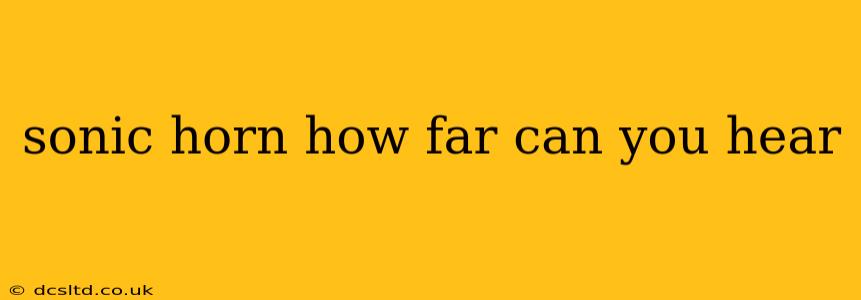The distance you can hear a sonic horn depends on a multitude of factors, making a simple answer impossible. It's not just about the horn's power; the environment plays a crucial role. This article will explore the science behind sound propagation and the various elements that influence how far a sonic horn's sound travels.
What is a Sonic Horn?
Before diving into distance, let's clarify what a "sonic horn" entails. Generally, this refers to a powerful, high-intensity sound-producing device, often used for fog signals, train warnings, or industrial applications. These aren't your typical car horns; they generate significantly more intense sound pressure levels (SPL). The type of horn – whether it's an air horn, electronic horn, or a diaphragm horn – also affects its sound projection.
Factors Affecting the Audible Range of a Sonic Horn
Several key factors determine how far you can hear a sonic horn:
1. Sound Power Level (SPL) of the Horn
This is perhaps the most significant factor. A horn with a higher SPL will naturally travel further. SPL is measured in decibels (dB) and represents the intensity of the sound. A higher dB rating indicates a louder and more powerful sound.
2. Ambient Noise Levels
Background noise significantly impacts audibility. In a quiet environment, a sonic horn's sound will travel much further than in a noisy city center with heavy traffic, construction, or industrial activity. The ambient noise effectively masks the horn's sound, reducing its effective range.
3. Atmospheric Conditions
Temperature, humidity, and wind all influence sound propagation. Temperature gradients can refract sound waves, causing them to bend upwards or downwards, affecting how far they travel. Humidity can absorb sound energy, reducing its range, while wind can either carry the sound further in its direction or impede its progress.
4. Terrain and Obstacles
Geographical features and obstacles like hills, buildings, trees, and even dense foliage absorb and scatter sound waves. The more obstacles between the horn and the listener, the shorter the audible range. This is why you might hear a horn clearly in an open field but not as well in a city.
5. Frequency of the Sound
The frequency of the sound produced by the sonic horn also affects how far it travels. Lower frequencies tend to travel further than higher frequencies because they are less prone to scattering and absorption by the atmosphere and obstacles. Many sonic horns are designed to produce lower frequencies for this reason.
How Far Can You Hear a Sonic Horn? There's No Single Answer!
Given the numerous variables, providing a precise distance is impossible. While some extremely powerful sonic horns might be audible for several kilometers under ideal conditions (low ambient noise, flat terrain, favorable atmospheric conditions), it's more realistic to expect a range of only a few hundred meters in typical environments.
People Also Ask (PAA) Sections: Answering Your Questions
Here we tackle some common questions regarding the audible range of sonic horns:
How far can a ship's horn be heard?
The audible range of a ship's horn depends on its power, atmospheric conditions, and ambient noise. It can range from a few hundred meters to several kilometers under ideal conditions, but it's highly variable. Regulations often specify minimum audible ranges for safety reasons.
What is the range of a fog horn?
Fog horns, a type of sonic horn, are designed for long-range audibility in challenging conditions. Their range can extend for several kilometers, but this again is subject to all the aforementioned environmental factors.
Can a sonic horn travel over hills?
While sound can diffract (bend) around hills to a certain extent, significant elevation changes will significantly reduce the range of a sonic horn. The sound will be significantly weaker and potentially inaudible on the other side of a large hill or mountain.
How is the sound of a sonic horn measured?
The sound of a sonic horn is measured using sound level meters that determine its sound pressure level (SPL) in decibels (dB). Measurements are typically taken at various distances from the horn to characterize its sound propagation.
In conclusion, the distance a sonic horn's sound can travel is highly contextual and dependent on numerous interacting factors. While a simple numerical answer isn't possible, understanding the science behind sound propagation allows for a more informed appreciation of its range and limitations.
